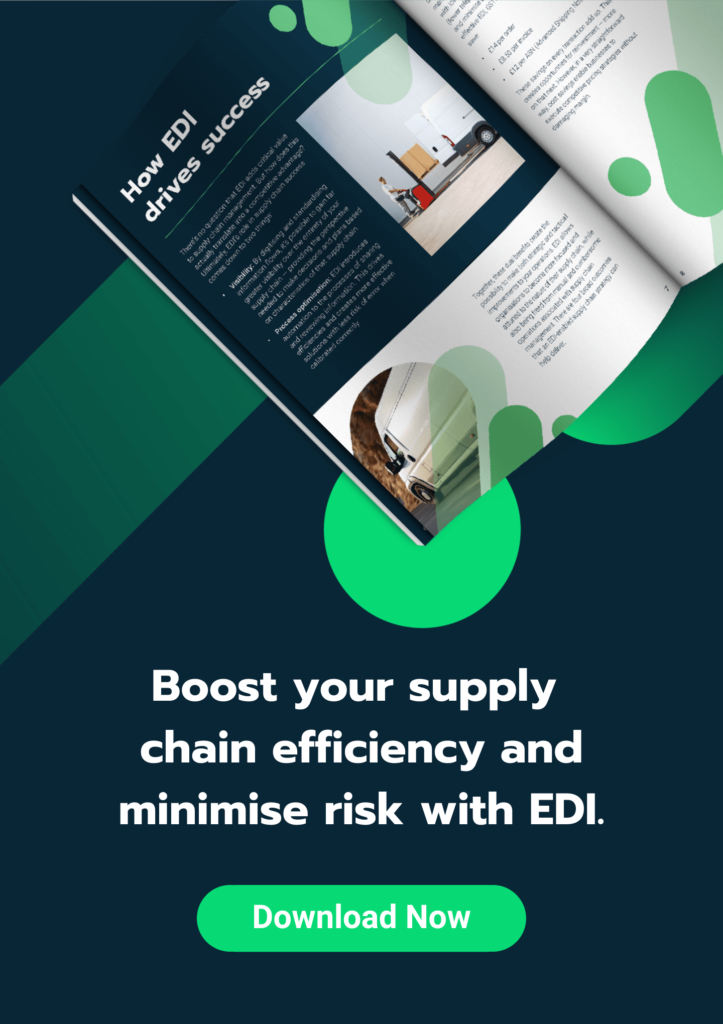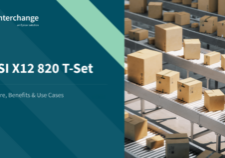The Advantages of EDI in E-Commerce: How to Gain a Competitive Advantage Online in 2021
The past twelve months have seen an explosion in eCommerce, with the industry’s share of global trade rising from 14% in 2019 to 17% in 2020.
Whilst these trends represent a largely positive development for the industry there are some new areas for concern. eCommerce has become even more cutthroat and fast-paced than before, and in the context of increasingly globalised supply chains, a large increase in orders represents the potential for disruption and previously unforeseen challenges to business.
Electronic Data Interchange (EDI) is a pivotal tool which can be used to address unique challenges in eCommerce which have been exacerbated by the recent boom and some of the more long-term obstacles the industry faces. Not all EDI solutions are the same, however, and it’s important to understand these specifics in order to take full advantage of the benefits EDI is equipped to deliver.
Here, we are going to look at these trends in the specific context of eCommerce — helping your business make informed decisions and gain a competitive advantage in the market with the help of EDI.
The unique challenges of eCommerce
Even before the unprecedented events of 2020, eCommerce had its own list of inherent and unique challenges. These include:
- Global supply chains: A reliance on supply chains which stretch across numerous countries can create issues for eCommerce’s business as a result of long-range logistics, delays, numerous time zones and accountability.
- High growth: The increase in internet access in developing countries, as well as the rise in web traffic generated by smartphones and tablets across the world, continues to drive eCommerce sales, forcing industry leaders to adapt to constant growth.
- Complex return processes: A ‘buy online, return in store’ policy can create unexpected costs for eCommerce businesses, with physical store space and staff capacity required to process returns. Difficulties can also emerge from the development and integration of IT systems to cope with demand for online returns.
The eCommerce landscape in 2021
Following the boom within the industry during the last twelve months, which saw the UK’s eCommerce sector enjoy its highest online sales growth in 13 years, eCommerce faces a new series of challenges in 2021 and beyond:
- A more competitive marketplace: A rise in sales and an increased scope for the industry means that fierce competition for customers and accelerated demand looks to be inevitable.
- Increased customer demand and expectations: The recent sharp increase in eCommerce trade brings with it both higher demand and enhanced expectations, necessitating a clearer focus on maintaining high levels of customer satisfaction.
- Supply chain pressures: Lockdown restrictions across the world in 2020 demonstrated the need for supply chain flexibility. Moreover, the accelerated growth of eCommerce observable during the past year, coupled with a reliance on speedy production, increases the strain on supply chains.
How EDI delivers eCommerce solutions
EDI was developed to simplify supply chain management. By automating the exchange of information, greater visibility, improved efficiency, and streamlined workflows can all be achieved. Fundamentally, effective EDI implementation is one of the most efficient ways for eCommerce businesses to mitigate and overcome many of the challenges the industry faces traditionally and those which have emerged more recently.
The advantages of EDI implementation within eCommerce include:
- Increased speed: Business cycles can benefit hugely from EDI, as waiting times and reliance on postal services is severely reduced/eliminated.
- Cost savings: As manual processes are scaled back post-EDI implementation there is a reduced reliance on paper documents, and as a result opportunities to reduce costs.
- Greater accuracy: By removing the need for paper documents, electronic data interchange significantly reduces the room for human error in supply chain management.
- Time-saving for staff: A reduction in manual processes also creates additional capacity for staff to focus on higher-value tasks within the business.
- Increased efficiency: The combination of enhanced speed and accuracy enables more focus to be placed on other areas of business activity.
Using EDI to Create a Competitive Advantage
When utilised effectively, EDI is a tool which can significantly improve supply chain management. But what does EDI actually offer businesses in terms of competitive advantage in the market?
- Visibility: Through standardisation and digitisation, businesses are able to gain better visibility over supply chains by developing a single-source-of-truth. This can add some much needed perspective, a necessity when making strategic decisions and long-term plans based on supply chains specifics.
- Competitive pricing: Given the implementation of an effective EDI solution enables the reduction of costs related to manual supply chain management processes, businesses have the opportunity to develop a competitive price strategy and focus on increasing profit margins.
- Reinvestment: Higher margins also create the possibility of reinvestment throughout the business. This then opens the door to a virtuous cycle, thereby allowing businesses to reinvest, create further effeicines and drive growth.
Whilst the above advantages are clearly appealing to businesses across the eCommerce industry they have one common theme — they require the implementation of an effective and modern EDI solution before they can become a reality.
The deficiencies of legacy EDI
EDI has the potential to deliver meaningful outcomes for businesses in an increasingly unforgiving eCommerce market. Despite this, it is important to recognise that legacy EDI solutions may struggle to effectively manage the modern and complex supply chains which are widespread in eCommerce.
Even with the considerable benefits it offers, legacy EDI, which incurs minimal data and hosting costs, comes with its own set of challenges. Unfortunately, these challenges can considerably hinder the significant benefits EDI has to offer. These include:
- Numerous protocols and standards: A wide range of EDI protocols and standards represent a severe challenge to effective supply chain management, and as a result limit the ability of any single EDI systems to function across a supply chain.
- Slow and complex onboarding: On-premise EDI solutions can significantly complicate onboarding new partners, hampering supply chain flexibility.
- Corrupted information: Ad hoc and legacy EDI systems can result in siloed relationships as well as manual processes that can corrupt data, thereby reducing supply chain efficiency.
- EDI protocols in the supply chain: Different methodologies, standards and levels of understanding across the supply chain can create difficulties for businesses and have a detrimental impact on flexibility, particularly when it comes to onboarding processes.
EDI-as-a-Service: a modern EDI update ready for eCommerce flexibility
The introduction of cloud-based tools and management services to the market allow the deployment of a more efficient EDI system even within the most complex global supply chains.
Businesses looking to remain competitive in the eCommerce market are likely to seek out modern, non-static EDI solutions which allow them to react decisively to emerging trends. That’s why at Data Interchange we’ve been working to update EDI. Our solution seeks to meet the demands of twenty-first century supply chains, and deliver a solution fit for eCommerce in 2021.
The result is EDI-as-a-Service. Our flexible, hybrid EDI model, which utilises cloud-based tools and managed services to match the idiosyncrasies of complex supply chains whilst optimising EDI outcomes for your operation.
The benefits for customers who make the transition to EDI-as-a-Service are numerous, and imperative for businesses looking to stay ahead of their competitors. These include, but are not limited to:
- Complete visibility: through the use of dashboards and cloud-based tools, EDI-as-a-Service is equipped to provide a one-source focus to digitisation.
- Flexibility: by accommodating a wide range of protocols and standards, EDI-as-a-Service enables a swift, agile onboarding process which, through an automated process, accommodates a wide range of supplier familiarity with EDI without creating additional challenges for the business.
- Simplicity: EDI-as-a-Service looks to remove unnecessary complexity through smooth supply chain integration processes. Furthermore, cloud-based EDI facilitates access throughout the supply chain.
- Efficiency: as a result of simple integrations which are made possible by EDI-as-a-Service, manual process which can be phased out, saving valuable time and resources.
- Creative planning and control: each of these benefits contribute towards an enhanced ability to plan and control your supply chain. Furthermore, this effective mitigation of EDI-based issues also enables more focus to be placed on other business activities.
Suggested reading: If you want to learn more about EDI-as-a-Service, check out our blog — How EDI-as-a-Service Changes Supply Chain Best Practices in 2021.
Gaining your competitive advantage
EDI is a complex, evolving methodology. Fortunately, Data Interchange is able to provide businesses with expert advice and guidance to ensure the implementation of the most effective EDI solution.
2020 was a year like no other for eCommerce, with a significant expansion in scope for the entire industry. As a result, businesses looking to gain a competitive advantage in 2021 and beyond will require an EDI solution which facilitates improved strategic planning, develops opportunities for cost savings and drives efficiency through process optimisation.
As eCommerce continues to see increased levels of demand, Data Interchange can help to ensure that your business is prepared with an effective and flexible supply chain management solution which gives you the edge over your competitors. If you’re looking for a fresh approach to EDI, optimised scalability, increased efficiency or supply chain integration, get in touch today.

































































































































